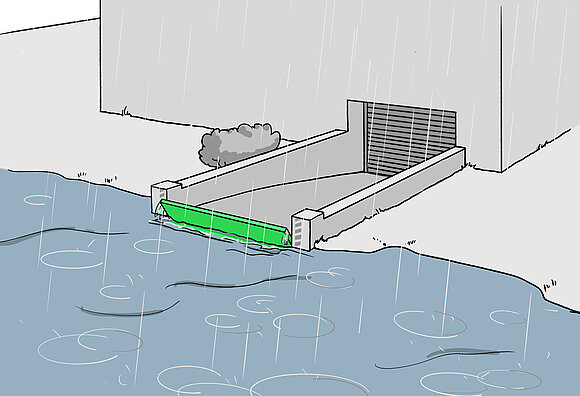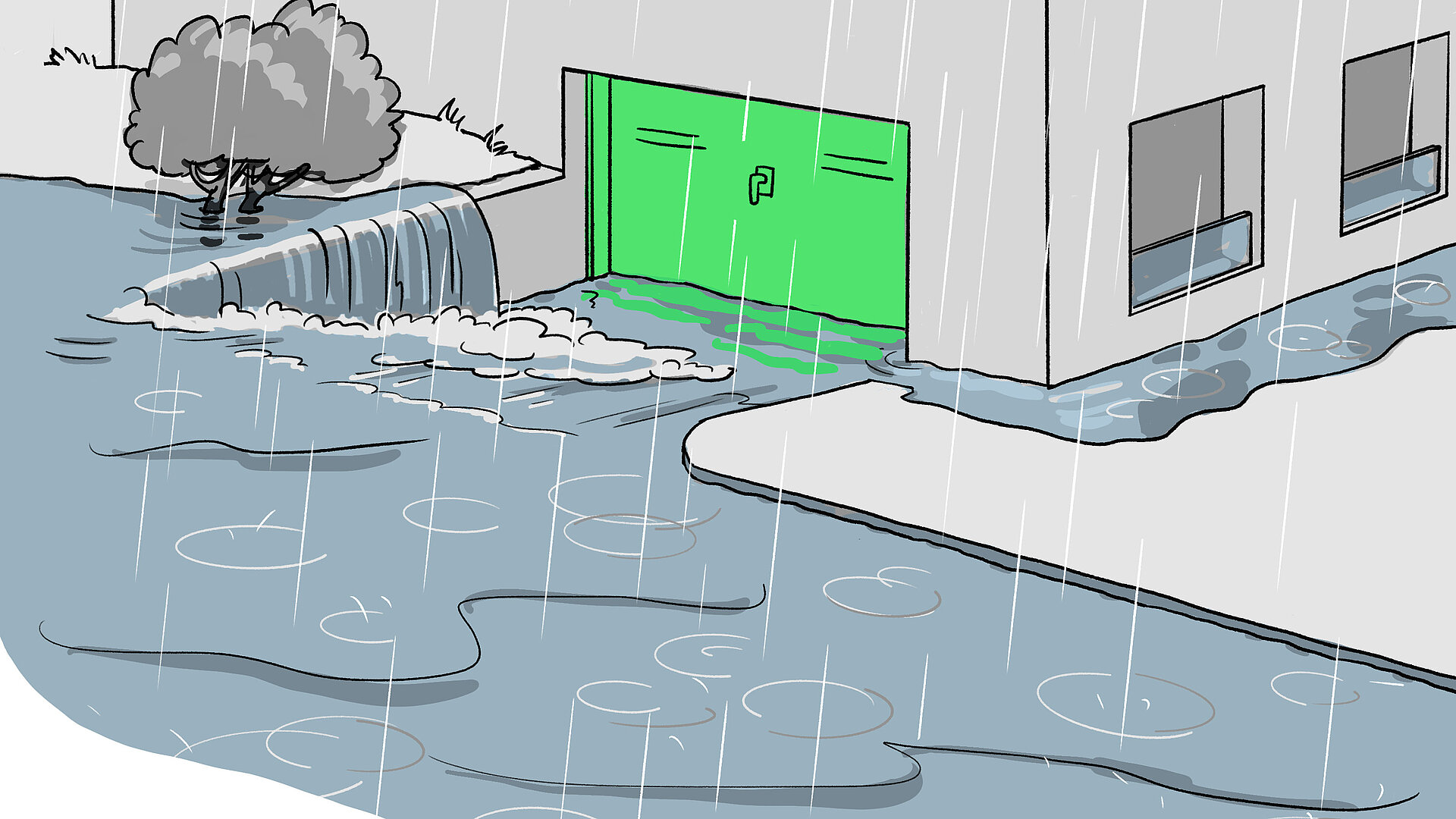Reading time: 1 minute
How often do we have to be surprised? The time spans of the news reporting on extreme weather events are getting shorter and shorter. Repairing damage and supporting victims of natural disasters is becoming commonplace. What contribution can the building industry make here?
This article was automatically translated from German into English with the help of DeepL.com.
Regional heavy rain overwhelms drainage systems at the point of precipitation. Floods occur because masses of water flood regions that are inadequately protected, even after many kilometers, via branching waterways. This results in extremes that buildings, with their material assets as the last link in the chain, are often unable to withstand.
Hailstorms are also becoming more frequent, with the size of the center punches increasingly exceeding that of a golf ball. Extreme storms and/or gusts and tornadoes are also becoming more frequent, with the term hurricane already gaining in importance in our Central European area.
If we look at heavy rain and floods, elaborate landscape planning measures are being taken by the federal states, municipalities and cities to increase safety. However, there are weak points in the landscape or buildings in many places where property owners must or should make a contribution themselves, not least to avoid financial losses. Damage to buildings caused by storms or hail can be counteracted by the selection of suitable units or materials. Units that have implemented the performance characteristics of resistance to the aforementioned influences without restricting daily, original use are more convenient.
Test and assessment of building elements
Verification management is carried out using established test engineers and methods of evaluation:

Basement window (Source: ift Rosenheim)
Heavy rain and floods
If we consider the pure load of the units due to rain, the verification management for windows and external pedestrian doorsets is carried out under the system designation "Watertightness" and by the European testing methods according to EN 1027 [1] with a classification according to EN 12208 [2]. It is up to the specifier to adhere to the country-specific requirements or recommendations (recommendation in Germany: DIN 18055 [3]) with regard to the necessary classification or - deviating from this - to place higher demands on the building element, as heavy rain is increasingly to be expected.
The watertightness test ensures that rainwater is drained away in a targeted manner without allowing moisture to enter the room to be protected. This does not yet provide evidence of protection against floods. Evidence of Performance against a static water column is provided on the outside. This is where the ift-Guideline FE-07/1 [4] comes into play. The building element is gradually flooded on the outside, taking into account the installation variant, and the leakage is determined.
As the topic of flood protection and possible comparable testing methods has gained more weights in recent years, the VdS also published the "VdS guidelines for flood protection systems for property protection" [5] at the end of 2022. At this point, it is important to mention that special attention was paid to the verification method of protection systems for indirect property protection. According to the definition in the guidelines, direct and indirect object protection differ in that the protection system is integrated directly into the object to be protected (e.g. window, Façade, door or gate) and/or is upstream of the object (e.g. insulating beam or sheet pile wall systems or flap and hose systems).


In this second latch, the performance characteristics such as resistance to upstream flow, overflow, hydrodynamic load (waves) and impact resistance are supplementary to the hydrostatic load, which can be identified as a single performance characteristic for building components in direct object protection.
Hail protection
Normative verification options for resistance to hailstorms according to European standards are available for flexible sheets for waterproofing. However, damage to building elements or materials used in the building element sector must also be assessed. For this reason, the Association of Cantonal Fire Insurers (VKF) in Switzerland has drawn up general and product and/or material-specific test specifications in order to ensure comparability in the assessment.
The test is carried out by firing hailstones of different dimensions, which is also reflected in the classification. Thus, there are hail resistance classes HW1 to HW5, in which the nominal diameter of the projectiles corresponds to 10 to 50 mm. Depending on the Class, the projectiles are also accelerated differently, so that energy inputs of 0.04 J to 31.5 J occur. If a positive classification can be achieved, the product can be included in the hail register(www.hagelregister.ch and/or www.hagelregister.at), to which building owners, layout engineers or other interested parties have accessibility and can also obtain additional information.
Hurricane
Evidence of Performance of Resistance to wind load according to European standards experts has so far been sufficient for the Central European area. However, higher wind speeds are increasingly being measured. The term hurricane is gaining ground. To date, European test bases have not provided comparable verification options to those known from America. Thus, the standards ASTM E 1996 [7] is operated as a standard specification for the performance of building elements hit by windblown debris during hurricanes and ASTM E 1886 [8] as a standard test method for the behavior of building elements hit by windblown debris and exposed to cyclic pressure differences.
Apart from impact loads - including those caused by vertically flying squared timbers that impact selectively - cyclic loads are applied. If the European standard tests with 50 alternating positive pressure/suction loads, the load according to ASTM E 1886 is more varied and intensive. The building element is tested under eight different pressure frequencies with positive and negative loading directions. At the extreme pressures, 50 cycles are loaded and at the lower pressures up to 3500 cycles. Similar test bases are also currently being processed at European level under ISO TC 162 / WG5, which underlines the significance of the topic of such transformations in Europe.
Conclusion
In addition to tests according to European standards as a basis for possible or mandatory declarations of performance, there are verification options in relation to weather extremes that are gaining in importance. Every licenser or manufacturer is called upon to clarify whether they wish to supply products for the market segment that can be substantiated with classifications based on the associated tests.
Literature
- DIN EN 1027:2016-09 Windows and doors - Watertightness (EN 1027) - Testing method
Beuth Verlag GmbH - DIN EN 12208:2000-06 Windows and doors - Watertightness (EN 1027) - Classification Beuth Verlag GmbH
- DIN 18055:2020-09 Criteria for the use of windows and external pedestrian doorsets according to DIN EN 14351-1 Beuth Verlag GmbH
- ift-Guideline FE-07/1:2005-10 (under revision) Flood-resistant windows and doors ift Rosenheim
- VdS guidelines 3855:2022-12 VdS guidelines for flood protection systems for property protection VdS Schadenverhütung GmbH
- www.schutz-vor-naturgefahren.ch
- ASTM E 1996 Standard Specification for Performance of Exterior Windows, Curtain Walls, Doors, and Impact Protective Systems Impacted by Windborne Debris in Hurricanes ASTM International, West Conshohocken, PA 19428-2959. United States
- ASTM E 1886 Standard Test Method for Performance of Exterior Windows, Curtain Walls, Doors, and Impact Protective Systems Impacted by Missile(s) and Exposed to Cyclic Pressure Differentials ASTM International, West Conshohocken, PA 19428-2959. United States


